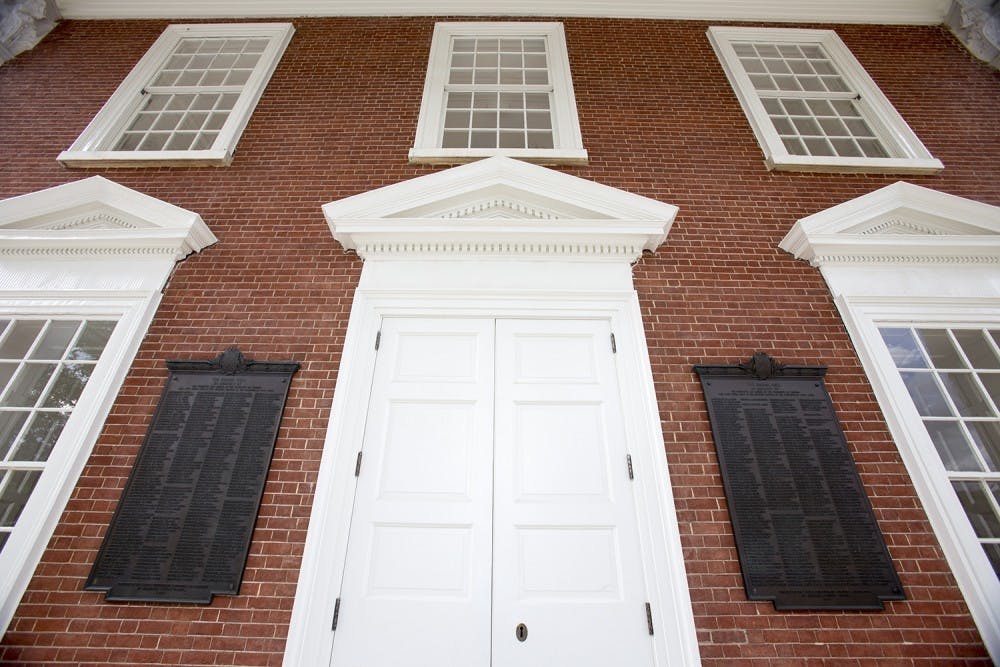Recent white supremacist and white nationalist activity in Charlottesville has spurred debate concerning the memorialization of the Confederacy and those who fought for it. In response to the unrest on Aug. 11 and 12 — culminating in the deaths of counter-protester Heather Heyer and Virginia State Police officers Lieutenant H. Jay Cullen and Trooper Berke M. M. Bates — municipal leaders and citizens across the South and America as a whole are calling for the removal of Confederate monuments. On Sept. 15, the University’s Board of Visitors voted to take down the plaques on the Rotunda memorializing Confederate soldiers with ties to the University who died in the Civil War. The Board of Visitors made a grave mistake which reinforced current trends towards historical erasure, and the plaques should be restored to their original location to strengthen historical remembrance and perspective.
One of the most significant issues related to taking down Confederate monuments is the endorsement of historical erasure which enables such action. Harvard University professor Annette Gordon-Reed argues that “the removal of [Confederate] monuments is not an erasure of history, but an effort to revise the popular account toward a more accurate one.” She further asserts that taking down Confederate monuments will not lead to attacks on the images of slave-owning Founding Fathers like George Washington and Thomas Jefferson. “We can distinguish between people who wanted to build the United States of America and people who wanted to destroy it. It’s possible to recognize people’s contributions at the same time as recognizing their flaws.”
However, Gordon-Reed’s argument is lacking. Student Council endorsed the Black Student Alliance’s list of demands condemning the statue of Jefferson in front of the Rotunda as an emblem of white supremacy. Furthermore, on Sept. 12, students, alumni and Charlottesville residents gathered at Jefferson’s statue and protested his influence and legacy at his University. It is absolutely ridiculous that anyone would protest Jefferson’s legacy at the University he founded, and these examples show how no part of our history is safe from erasure.
Plaques such as those that once resided on the Rotunda and other monuments to Confederate veterans help tell a complete story of Virginia and the rest of the South. The Civil War speaks to a time when the United States was so divided that the states of South Carolina, Mississippi, Florida, Alabama, Georgia, Louisiana, Texas, Virginia, Arkansas, North Carolina and Tennessee seceded from the Union and formed the Confederate States of America. Considering the current political climate in which many Americans feel the country is divided, reminders of the challenges our nation has overcome in the past can help put our current problems in perspective.
There is widespread support for maintaining monuments to the Confederacy among large parts of the general American population, including its black population — for good reason. Civil rights activist and former mayor of Atlanta Andrew Young speaks in favor of maintaining Confederate memorials such as the monumental relief carving of General Stonewall Jackson, General Robert E. Lee and President of the Confederacy Jefferson Davis on Stone Mountain in Georgia. When asked to consider Black Lives Matter activists’ calls to remove Confederate monuments, he argued that “these are kids who grew up free, and they don't realize what still enslaves them — and it's not those monuments.”
Young is correct to argue that the contention surrounding Confederate memorialization distracts us from more pressing issues facing our nation, including its black community.
In order to represent the truth more wholly, future revisions to our historical narrative must be additive instead of subtractive. Drawing from Dr. Martin Luther King, Jr., Young recommends enhancing the historical narrative of Stone Mountain. “I would only consider adding to it a freedom bell because Martin Luther King said in his speech, ‘Let freedom ring from Stone Mountain [of] Georgia.’ He named that specifically.”
The University is right to have commissioned a monument to the University’s enslaved workers to be built east of Brooks Hall and within sight of the Rotunda. Memorials such as these and those to the Confederate dead tell the full story of the University and combat the movement towards erasure that the Board of Visitors endorses. Memorializing those with connections to the University who fought and died for the preservation of the Union would also constructively address this issue. Suppressing our past would not.
Thomas Ferguson is a Viewpoint Writer. He can be reached at opinion@cavalierdaily.com.







